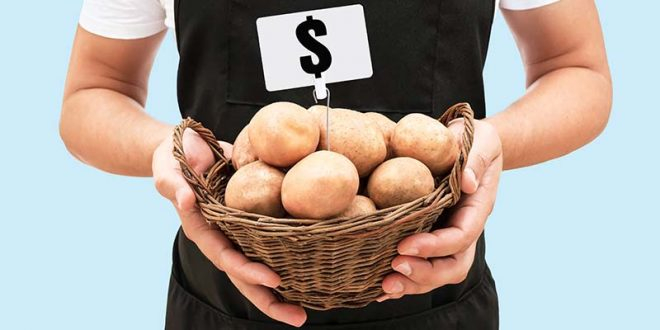On January 5, 2023, during the Q2, 2023, earnings call between analysts and top management from Lamb Weston, the company’s CEO, Tom Werner, stated that the decision-makers had secured the targeted number of acres to be planted as well as nearly a 20% increase in contract prices for potatoes grown in the Columbia Basin for the upcoming crop.
During the call, the CEO of Lamb Weston stated that the company has been processing this year’s harvest’s potatoes for a few months and has continued to evaluate the overall quality of the tubers in the major growing regions, including shape, color, the degree of defects, and the solid content as being consistent with historical averages.
“Yields, however, are below historical averages and below the preliminary assessment that we provided during our earnings call in October (2022). To fill our production needs, we have secured additional potatoes in the Columbia Basin and Idaho and are sourcing potatoes from other regions in North America, including the East Coast. This will add to our potato costs for the remainder of fiscal 2023, and we have included the estimated impact in our updated financial targets for the year. Concerning next year’s potato crop, we’ve agreed to nearly a 20% increase in contract prices for potatoes grown in the Columbia Basin and have secured the targeted number of acres to be planted. Our discussions with growers in Idaho and Alberta on price and acreage are ongoing. (…) Where the potato crop negotiations, we settled with Pacific Northwest, you’re going to be up 20% next year. And you stack that up over two years, that’s a big lift. And it’s going to be another difficult year, and we’ll continue to adjust our thinking on pricing that through the market going forward, but it’s not going to be material margin impact year-over-year just based on sourcing out of the East Coast,” the CEO mentioned.
French fry Demand in the U.S. Remains Solid
Concerning the Q2 of the current fiscal year (FY – starting on October 1st, 2022, and ending on September 30th, 2023), Werner mentioned that overall French fry demand in the U.S. remained solid although the total restaurant traffic remains below pre-pandemic levels.
“It’s up versus the prior-year quarter, and trends are up sequentially off the lows we saw in the summer, as gasoline prices spiked. Demand and traffic trends in the quarter varied by channel, as consumers reacted to broad-based inflation and the threat of a recession,” Weston said during the call.
He added that Quick Service Restaurant (QSR) traffic was up versus the prior year, and trends improved sequentially versus Lamb Weston’s fiscal first quarter, as consumers adjusted to less expensive dining options.
“As expected, casual dining and full-service restaurant traffic in the quarter was down versus the prior year, although trends also improved sequentially versus our fiscal first quarter. This year-over-year decline in casual dining and full-service restaurant traffic had a more pronounced effect on our Foodservice segment, which has greater exposure to these sales channels and contributed in part to a decline in the segment’s volume. The fry attachment rate, which is the rate at which consumers order fries when visiting a restaurant or other food service outlets remained above pre-pandemic levels,” the company’s CEO mentioned.
Volatile Restaurant Traffic Demand Trends
Tom Werner added during the call that the demand and traffic patterns for restaurants will remain unpredictable through the fiscal year 2023. But in the second quarter of the current fiscal year, retail French fry demand remained strong.
“It’s been strong since the start of the pandemic as consumers pull back spending on dining out. Demand for our retail products sold under licensed restaurant brands, in particular, remained strong over the past year as consumers look to have the restaurant-style fries they love while at home. While fry demand across all our channels is holding up well, we continue to struggle to meet that demand due to the impact of supply chain disruptions on run-rate and throughput in our production facilities,” Lamb Weston’s CEO declared.
He added that over the past year, these disruptions have been largely related to the impact of shortages in certain commodities, such as starches and edible oils as well as factory worker shortages and availability.
“The availability of key commodities has slowly improved over the past couple of quarters as we broadened our supplier base and qualified substitute ingredients when possible. Yet it remains a concern, and we expect it will continue to affect our production volumes at least through the remainder of fiscal 2023,” he explained.
Lamb Weston’s net sales increased from USD269.9m to USD1,276.5m, up 27% versus Q2, 2022. Price/mix increased by 30%, reflecting the benefit of product and freight pricing actions across each of the Company’s core business segments to counter input, manufacturing, and transportation cost inflation.
Volume declined by 3%, primarily reflecting an inability to fully serve customer demand in the Company’s food service and retail channels. The impact of supply chain disruptions during the quarter, including the effects of commodities shortages and onboarding new production workers, continued to affect production run rates and throughput in the Company’s production facilities as well as customer order fulfillment rates.
To a lesser extent, softer casual dining and full-service restaurant traffic in the U.S. also contributed to the volume decline as consumers continue to face a challenging macroeconomic environment.








